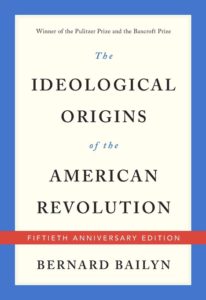All praise to the humble pamphlet, upon which *may* rest the ideological origins of the American Revolution. Frequently buried by history as loose “Bundells of Pamphlets in quarto,” it’s a genre that almost shouldn’t be. Printed on flimsy paper and easily battered by salt spray or avid readers, the popular pamphlet became a clutch genre for British and American revolutionaries to send ideas around the Atlantic World. These publications, along with newsbooks, hardened into the “paper bullets,” that, according to scholar Joad Raymond, flew on and off the page in early modern England’s press.
Even as the genre evolved into weekly newspapers, he writes, “readers recognized the rules of the form.” Pamphlet culture, a dynamic arena for anonymous critics to take an eloquent swipe at matters of church and state, quickly blossomed abroad. Unbound and unfettered, pamphlets seeded colonists with a new political consciousness. Whether 10 pages or 50, these slim booklets amplified republican politics and revolutionary prose. Pamphlets, as Robert G. Parkinson observes, became the “lifeblood” of the American Revolution. “They instructed the colonial public that political and personal liberty were in jeopardy because British imperial reformers sought to strip them of their natural rights, especially the right to consent to a government that could hear and understand them,” he writes. Today, let’s look at that instructional aspect of pamphlet culture, and how Bernard Bailyn’s interpretation of revolutionary tracts has reshaped what we do in public history.
Like Michael Hattem, I encountered Bernard Bailyn, and his Ideological Origins of the American Revolution, at a critical point in my graduate studies. Reading his landmark work alongside J.G.A. Pocock’s Ancient Constitution and the Feudal Law: A Study of English Historical Thought in the Seventeenth Century and James Harrington’s Oceana, I tried to track the rise and fall of a vast host of ideas. Many index cards later, I found that the revolution’s pageantry of print culture only kept unspooling, and upsetting narratives. Luckily, he cited some of the material that I dealt with at work, identifying the pamphlets that John and Abigail Adams referred to in their epic correspondence. Toggling between my (then) new, full-time post at the Adams Papers editorial project and a steep blizzard of reading for graduate school, I shuttled through several commutes with IOTAR in hand.
 Early on, I chose to read Bailyn’s work with a public history career in mind. A newcomer to the field of scholarly editing
Early on, I chose to read Bailyn’s work with a public history career in mind. A newcomer to the field of scholarly editing
, I savored the art and science of his approach. Curious to see how it compared with the editorial process at the Adams Papers, I marveled at the collaborative hunt to locate those pamphlets in a pre-Internet age. Bailyn’s selection rate for documents was fairly rigid: Only 72 of 400 were printed in the final volumes. I read the IOTAR as an extended headnote: an eloquent, book-length model of scholarly annotation. Long a champion of founding-era scholarly editions since their midcentury inception, Bailyn was nimble in curating rare documents in order to drive home his historical arguments. “We ask a great many more questions of our texts than our predecessors did,” Julian P. Boyd, editor of the Papers of Thomas Jefferson, told the American Historical Association in 1955. In turn, Bailyn’s work set me on a career to find documents and ask questions.
Bailyn’s opus has earned an automatic spot on comprehensive exam lists for half a century. Beyond university walls, IOTAR has influenced public history’s many forms. We write exhibit labels, make digitization choices, and apply for preservation funding with multiple narratives meant to frame the Revolution, including Bailyn’s, spread across the table. Historiographical trends like print culture’s prominence also migrate far past university walls. Librarians, archivists, scholarly editors, park rangers, and museum professionals stay attuned to big interpretive shifts. We practice intellectual history daily, and in dialogue with the public. Bailyn’s IOTAR overlapped with radical changes in how we think about who made the Revolution, and which legacies we present as a shared and/or usable past in our displays.
For S-USIH and Junto readers ready to begin Bailyn’s kind of research project today, how has access to revolutionary-era material changed? Good news for pamphlet fans: Since IOTAR, conservation practices have modernized. Cataloging methods have been refined. Readers can sift the Newberry Library’s French Revolution manuscripts trove, browse Eighteenth Century Collections Online, and explore Dutch “pamflets” here
. (Share your favorite pamphlet finds, analog or digital, in the comments). I asked John Overholt
, Curator of Early Modern Books & Manuscripts at Harvard University’s Houghton Library, to weigh in on how library practices have evolved after IOTAR. “From what I see in our stacks it seems the breaking of pamphlet volumes and library-binding of unbound or disbound pamphlets was much more common then than today,” Overholt replied. “I think it’s part of a growing awareness that in the age of digitization, access to texts in and of themselves is of somewhat diminishing importance, but preservation of contextual evidence and signs of use is increasing in importance.” Practical advice from the archives here for intellectual historians of vast early America: To put revolutionary ideas in context, as Bernard Bailyn did, look for signs of use.


0